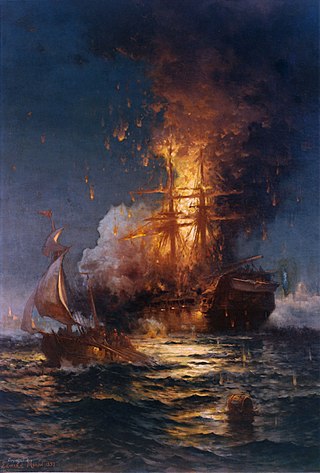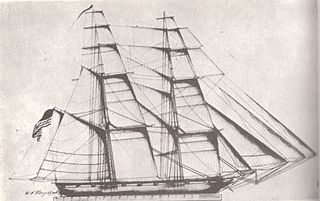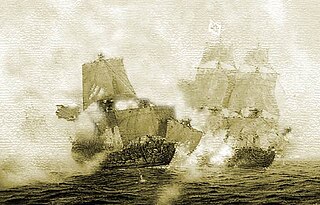
The Barbary Wars were a series of two wars fought by the United States, Sweden, and the Kingdom of Sicily against the Barbary states and Morocco of North Africa in the early 19th century. Sweden had been at war with the Tripolitans since 1800 and was joined by the newly independent US. The First Barbary War extended from 10 May 1801 to 10 June 1805, with the Second Barbary War lasting only three days, ending on 19 June 1815. The Barbary Wars were the first major American wars fought entirely outside the New World, and in the Arab World.

The Second Barbary War, also known as the U.S.–Algerian War and the Algerine War, was a brief military conflict between the United States and the North African state of Algiers in 1815.

The Barbary corsairs, Barbary pirates, Ottoman corsairs, or naval mujahideen were mainly Muslim corsairs and privateers who operated from the largely independent Barbary states. This area was known in Europe as the Barbary Coast, in reference to the Berbers. Slaves in Barbary could be of many ethnicities, and of many different religions, such as Christian, Jewish, or Muslim. Their predation extended throughout the Mediterranean, south along West Africa's Atlantic seaboard and into the North Atlantic as far north as Iceland, but they primarily operated in the western Mediterranean. In addition to seizing merchant ships, they engaged in razzias, raids on European coastal towns and villages, mainly in Italy, France, Spain, and Portugal, but also in the British Isles, and Iceland.
John Joliffe Yarnall (1786–1815) was an officer in the United States Navy during the War of 1812 and the Second Barbary War.

USS Guerriere was the first frigate built in the United States since 1801. The name came from a fast 38-gun British frigate captured and destroyed in a half-hour battle by USS Constitution on 19 August 1812. This victory was one of the United States' first in the War of 1812.

Commodore John Downes was an officer in the United States Navy, whose service covered the first half of the 19th century.

The Bombardment of Algiers was an attempt on 27 August 1816 by Britain and the Netherlands to end the slavery practices of Omar Agha, the Dey of Algiers. An Anglo-Dutch fleet under the command of Admiral Edward Pellew, 1st Viscount Exmouth bombarded ships and the harbour defences of Algiers.

The Mediterranean Squadron, also known as the Mediterranean Station, was part of the United States Navy in the 19th century that operated in the Mediterranean Sea. It was formed in response to the First and Second Barbary Wars. Between 1801 and 1818, the squadron was composed of a series of rotating squadrons. Later, squadrons were sent in the 1820s to the 1860s to suppress piracy, primarily in Greece and to engage in gunboat diplomacy. In 1865 the force was renamed the European Squadron.

The Mashouda or Meshuda was the Algerian fleet flagship of admiral Raïs Hamidou during the Second Barbary War. Commodore Stephen Decatur Jr. of the United States Navy captured her in June 1815 at the Battle off Cape Gata. This created a favorable American position from which to bargain with the Dey of Algiers. Lloyd's List reported that the Algerian frigate Mezoura, which had been under the command of the Algerine admiral, had arrived at Carthagena on 20 June 1815 as a prize to Decatur's squadron. The newspaper also reported that Decatur's squadron had run another Spanish frigate onshore near Carthagena.

The Battle of Cape Palos was the last battle of the Second Barbary War. The battle began when an American squadron under Commodore Stephen Decatur Jr. attacked and captured an Algerian brig.
USS Torch was a schooner—heavily armed with guns and carronades—in the United States Navy during the early years of the republic. She was built for service in the War of 1812, but did not see service until the Barbary Wars when she was sent with the American fleet to the Mediterranean to force an end to piracy of American ships.

HMS Epervier was an 18-gun Cruizer-class brig-sloop of the Royal Navy, built by Ross at Rochester, England, and launched on 2 December 1812. USS Peacock captured her in 1814 and took her into service. USS Epervier disappeared in 1815 while carrying dispatches reporting the signing of a treaty with the Dey of Algiers.

The action of 28 November 1751 was a naval engagement off Cape St. Vincent between a squadron of two Spanish ships of the line under captain Pedro Fitz-James Stuart and an Algerine squadron of two ships of the line under corsair Mohammed Chirif, which was fought from November 28 to December 2, 1751, and resulted in a victory for the Spanish fleet. The Algerine ships had come from the port of Algiers, and were acting as corsairs, conducting commerce raiding against Christian merchant ships and enslaving their crews. This was part of the Barbary slave trade, where the Barbary states, autonomous vassals of the Ottoman Empire, raided Christian settlements and merchant vessels for slaves to sell in their own cities. The corsairs targeted Spain, a Christian country, and the Spanish Navy was sent to track down the formidable Algerine force of two ships of the line, which posed a significant threat to any Christian vessels in the region. When the fleets sighted each other on November 28, 1751, they found that they were evenly matched with their opposition; both fielded two ships of the line.

Hamidou ben Ali, known as Raïs Hamidou, or Amidon in American literature, was an Algerian corsair. He captured up to 200 ships during his career. Hamidou ensured the prosperity of the Deylik of Algiers, and gave it its last glory before the French invasion. His biography is relatively well known because the French archivist Albert Devoulx found documents that told of this charismatic character.

Commodore Stephen Decatur Jr. was a United States Navy officer. He was born on the eastern shore of Maryland in Worcester County. His father, Stephen Decatur Sr., was a commodore in the Continental Navy during the American Revolutionary War; he brought the younger Stephen into the world of ships and sailing early on. Shortly after attending college, Decatur followed in his father's footsteps and joined the U.S. Navy at age 19 as a midshipman.

Omar Agha was the Dey of the Deylik of Algiers from April 1815 to September 1817, after the assassination of his predecessor Mohamed Khaznadji on 7 April 1815, who had been in office for only 17 days.

Haji Ali ben Khalil was Dey of the Deylik of Algiers from 1809 - 1815.
The Action of 22 May 1811 was a naval engagement between an Algerian fleet commanded by Raïs Hamidou, and a Tunisian one commanded by Mohammed Mourali, also known as al-Mourali.
The action of 27 May 1802 was a single-ship action which took place in the Mediterranean Sea, when a 36-gun Portuguese frigate, commanded by the French capitão de mar e guerra João Luís de Seguin Deshon, was captured by a 44-gun Algerian frigate, commanded by the privateer Raïs Hamidou.

The Portuguese-Algerian War was a period of diplomatic crisis between Algeria and Portugal, It was marked mostly by a series of naval battles that happened between 1790 and 1813, until they signed a friendship treaty in 1813, ending all hostilities.
















